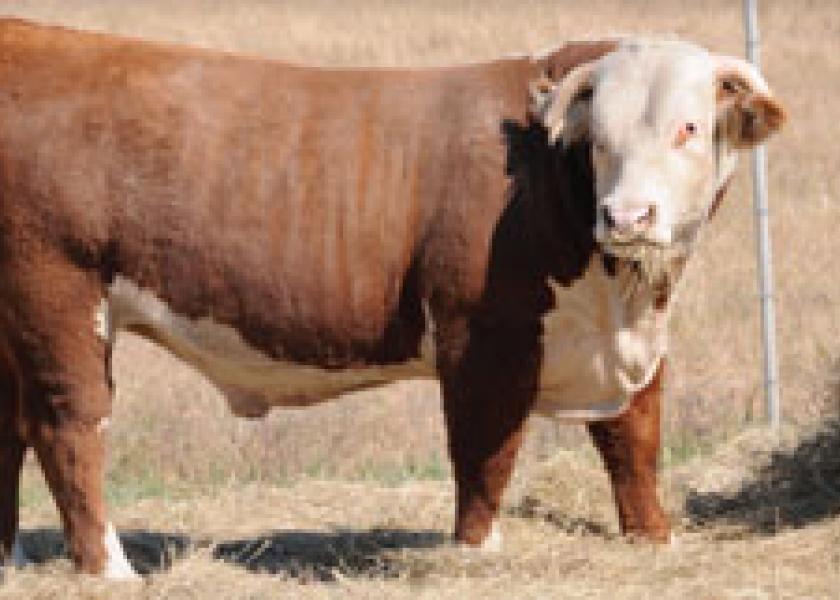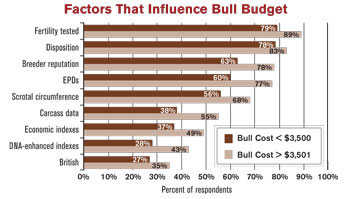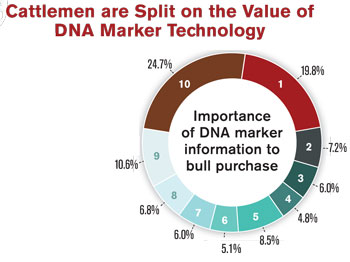Accuracy Adds Dollars

EPDs and genomic information advance bull selection
In a year when profits abound, cattlemen are eager to invest in their operation—upgrading equipment, improving fences and pastures, and increasing herd size. Don’t let bull selection fall too far down on the list.
“Bull selection accounts for 75% to 80% of the gene flow in your herd,” says Bob Weaber, a cow-calf Extension specialist at Kansas State University. “Replacement female selection is important, but sire selection is essential.”
One bull purchase impacts at least four to five calf crops—a legacy if he performs well, a long-term burden if he fails. With your future and bottom line riding on one or even a handful of bulls, you should take every opportunity to make the right choice.
“Expected progeny differences [EPDs] eliminate the environmental component that influences the phenotypes of animals. This gives us a clearer picture of the animal’s genetic merit than what a physical exam might tell us,” Weaber says.
While some EPDs are more important to producers’ goals than others, data is clearly a benefit when selecting your next herd sire(s). As genomic technology advances, there are even more tools to aid in the process.
In early September at the Hereford Genetics Summit, Jack Ward, chief operating officer and director of breed improvement at the American Hereford Association (AHA), gave an overview of spring 2014 Hereford
bull sales based on performance data. To target commercial purchases, he kept the price tag at $15,000 or less. Here are the highlights of their findings:
- The average price of a bull in the top 10% of the breed for calving ease was $5,750.
- Even if the bull was in the top 30% for calving ease, the difference in value was only about $1,000.
- Weaning weight and marbling traits values were similar to calving ease. “If we genetically made bulls the right way, it added value of at least $1,000,” Ward says.
- If you put a bull in the top 10% for calving ease, weaning weight and marbling, you can add another $2,000 to its value.
It was interesting to note what did not change a bull’s economic value—the difference in price for a bull that weighed 60 lb. at birth and one that weighed 95 lb. was zero. “Commercial guys may want [lower birth weights], but they weren’t really paying for it,” Ward says.
As the next step, Ward narrowed his study to bulls that offered genomically enhanced EPDs and sold for $15,000 or lower. On average, genomically enhanced EPDs added $2,100 to a bull’s value.
“The commercial industry today wants genomically enhanced EPDs when they buy bulls,” Ward says. “We’ve actually seen a tremendous spike in the number of genotypes at AHA. Right now, we have more than 10,000 animals with high density genotypes, and we have opportunities to do some great things in the area of genomics.”
Click on image to view larger picture |
 |
In an online survey from the American Hereford Association, producers who planned to buy higher value bulls were more likely to use EPDs and DNA-enhanced data. |
As new genomic tools are developed, the greatest value comes with increased accuracy. “Genomically enhanced EPDs help the seedstock producer make better decisions because the genetic information increased the accuracy of the EPD,” Weaber says. “But ultimately, that value gets captured by commercial cattlemen because they then have more accurate tools when making selection decisions.”
Accuracy of genomically enhanced EPDs is substantially undervalued, Weaber adds. The seemingly small change in accuracy is equal to one or two years of progeny testing. “That is a huge risk mitigation tool for commercial customers,” he adds.
While many seedstock cattlemen don’t report accuracy in sale catalogs, Weaber says commercial cattlemen need to push for the information. “I encourage seedstock producers to report those accuracies because it represents decreased risk to their customers and more value,” he says.
“The rate of genetic change in a herd is governed by how selective you are among candidates, how accurate your information is and how much genetic variation there is in your trait(s) of interest,” Weaber says.
We have little control over genetic variation, Weaber adds, “but we can and should make our selection decisions more accurate with more information that includes genomic data.”
For example, in Simmental cattle,adding genomic information to a yearling bull’s EPDs is equivalent to the accuracy gained by having six to eight progeny records for growth and carcass traits. “Think about the cost savings achieved to realize that modest change in accuracy—in terms of the amount of investment and time it would take to collect an equivalent number of progeny records for carcass traits, maternal calving ease or stayability,” he says.
“These traits are difficult to measure and are recorded later in life. They have huge price tags associated with them,” he says.
Increased accuracies for EPDs also bolster the reliability of economic indexes, which commercial producers rely on. “It’s a huge time saver. Most commercial guys never get any data on carcass or maternal traits, so having that information right up front at the selection decision is dramatically better than what historically has been available,” Weaber adds.
Even with these technology advancements and sale records showing higher accuracy sires are more valuable, some seedstock producers still fail to measure these crucial production factors.
“Genomic data is great for leveraging information from relatively small, intensively phenotyped populations, but seedstock producers must continue to collect a wide range of performance records. As an industry, we need to make reliable EPDs available to researchers,” Weaber says. “There is no shortcut around that.”
“What we can do with data, what we can do with genomics, is going to change what we can do with our cattle. It already has,” adds Craig Huffhines, AHA executive vice president. “Now we can augment that with DNA technology to give us some real predictability to know what those traits will do. That’s
exciting—that’s power.”
 |
In an online survey conducted by Beef Today this past summer, cattlemen were still divided on whether DNA marker information is an important factor in their bull selection. Of the 1,094 respondents, almost 20% rated it a value of 1 (least important), while almost 25% rated the factor a 10 (most important). |
What it Means to Me
- Bulls that were in the top 10% for calving ease, weaning weight and marbling brought more money at sale time.
- The seemingly small change in accuracy of genomically enhanced EPDs can be equal to the value of a year or two of progeny testing a bull.
- Most commercial cattlemen never receive data on carcass or maternal traits. By using the increased accuracy of genomically enhanced sires at selection, they can dramatically lower their production risk.
Four Areas of Genome Research to Watch
Use and development of genomically enhanced EPDs has increased research at several universities and actionable information is on the horizon.
“The cattle industry has an opportunity to step back and look at what other economically relevant traits we need to get our arms around in genetic evaluation,” says Bob Weaber, cow-calf Extension specialist for Kansas State University.
For example, udder score and quality has an effect on cow longevity, as different measures of fertility such as heifer pregnancy, first service conception rate, age of puberty and ability to rebreed as a three- or four-year-old. The major breeds are in varying stages of deployment of those kinds of traits depending on their data structure, Weaber says.
Next on the horizon is feed efficiency traits. “We are in year four of the feed efficiency project, a multi-university consortium funded by USDA, led by Jerry Taylor at the University of Missouri, and are generating deliverables from the genomic scans for Angus, Hereford and Simmental cattle, with other breeds to follow,” Weaber says.
Findings from a large USDA-funded BRD (bovine respiratory disease) project suggest moderate heritabilities for disease resistance phenotypes, when the records are collected in controlled environments.
New aspects of fertility research are also in play. Jerry Taylor and Dave Patterson at the University of Missouri, Megan Rolf at Oklahoma State University and Alison Van Eennenaam at the University of California-Davis are using DNA sequencing to study genetic defects that cause embryonic lethality. DNA sequencing the top pedigrees in several breeds will open the door to a wide array of genetic information.
Many breeders are asking for structural traits information, Weaber adds. Hereford and other breeds have a structural height EPD, but there is also interest in feet and leg structure, which have high levels of heritability and large amounts of genetic variability.







